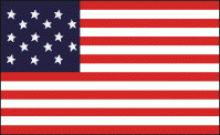|
American Flag |
This flag was in effect from 1795 to 1818. It is the only official United States Flag with more than 13 stripes. Two stars and two stripes were added upon the admission of Vermont and Kentucky to the Union. The staggered row pattern of the stars was standard practice for naval flags. American flags appeared in many different designs and numbers of stripes and stars, and it was not until 1818 that the design for the flag was standardized by Act of Congress. A congressman by the name of Windemer introduced a bill to standardize the flag in 1816, but the bill did not pass until March 25, 1818. The law went into effect on April 4, 1818. The 15-star and 15-stripe Flag is flown day and night at Fort McHenry in Baltimore, Maryland, the site of the battle in 1814 that served as the focal point of Francis Scott Key's poetic efforts, thus giving birth to the National Anthem of the United States. The flag is now known as "The Star-Spangled Banner"; the original is currently in the possession of the Smithsonian Museum of American History. The Star-Spangled Banner currently in the possession of the Smithsonian Museum of American History has an upside down red "V" (or incomplete "A") on the 10th white stripe. It is believed that the incomplete "A" was added in honor of Lt. Colonel George Armistead, who commanded Fort McHenry during the Battle in 1814. The Flag was in his family's possession from his retirement until it was donated to the Smithsonian in 1907. |

